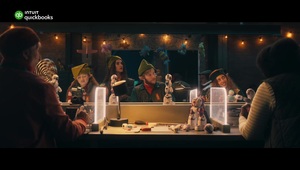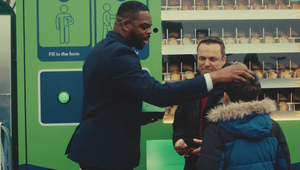
The “Incredible Power” of the Andrex Puppy, Explained

The story of the Andrex puppy goes back to 1972. The toilet roll brand, now in the hands of FCB London, was handled by J. Walter Thompson at the time. FCB chief strategy officer Ben Jaffé loves the serendipity of how it almost never happened. “They had an idea on the table where an angelic, blonde little girl was going to basically run around the house wrapped up in toilet roll,” he says. “And it was going to demonstrate the toilet roll's length above all else, but also its strength – two key qualities that the product has. But the ASA said you can't do that because that encourages wasteful behaviour.”
This was only a day or two before the shoot. Everything was booked. That’s when the art director chimes in saying he’s got an amazingly cute Labrador puppy and the ad can basically be the same concept, but rather than a cute little girl it’s a cute puppy. “It was a stroke of great fortune,” says Ben, “because the puppy, I think, has an ability to communicate with people far beyond the capabilities of the little girl. It wasn't male or female, any particular creed, race, or whatever else. And it's something that could be repeated over time.
“Dog ads and animal ads in general, are a neat way of overcoming casting issues,” he adds, “because people will often want to feel some sort of connection with the protagonist of communication. But as people, we also like to respond to people that look and feel like us. So while you’re possibly going to be alienating all sorts of people by using a person, by using an animal, we overcome that issue, because you can relate to it – assuming you're not more of a cat person. It's quite a neat tool.”
It’s not only because of dumb luck that the puppy has remained part of Andrex’s advertising for over 50 years though. It’s also because of strategists like Ben realising the value of the furry brand icon and putting it to good use. It’s a value that rests on over 20,000 years of humanity’s canine obsession.
“The evolution of dogs means that they are very effective communicators and have a very specific relationship with human beings in person, but also have the power to affect us just in images alone,” says Ben. “But I think the power of the Andrex puppy, beyond just the general cuteness of something soft and cuddly, has been in its eyes.
“The way that we relate with dogs is very specific. The domestication of wolves and breeding of dogs over millennia has meant that dogs have developed muscles around their eyes which wolves don’t have. There is a muscle called the LAOM [levator anguli oculi medialis], which is effectively like an eyebrow muscle. You know dogs often have little eyebrows and have the ability to raise their eyebrow to make their eye bigger? It has the effect of a schema, like a baby. It triggers a natural response in human beings. When you see a baby's face and big, wondrous eyes looking inquisitively at you, you want to take care of them. It triggers the natural instinct to care. You can't help but respond. When you see a puppy, people want to reach down and cuddle it, right?”
Ben goes on to link that with more of the research he’s done while working on the Andrex account, considering Carl Jung’s theory of archetypes. “He talked about how we have a number of different archetypes that exist within us that can be animated at specific moments in time. So there can be a life experience that animates a particular archetype within you, and there can be people and things that animate a particular archetype in you. For example, if you give a young child – who is in need of care and attention themselves – a puppy, it animates the instinct to care. The child will start to stroke it, cuddle it, look after it, feed it and give it water, take it for walks and all those kinds of things.”
That effect continues into adulthood of course. Which means puppies can provoke us to care about something. “Puppies have incredible power,” Ben goes on. “They have the ability to connect with people, young and old, and trigger that archetype that exists within you – the instinct to care. So for Andrex, it's been an incredibly powerful brand asset. Semiotically, care is baked into the brand. When you see Andrex, when you see the puppy, you have the desire to care – care for yourself, care for your family, care for those around you. And I think that's been utilised to varying degrees of success over the 52 years that the puppy's been around.”
That impulse is something that FCB London is using in a more nuanced way than we’re used to. In its current ‘Get Comfortable’ platform for Andrex, Ben and his colleagues have made efforts to go a level deeper. “It's something that we want to continue to use, but in a way that goes beyond just the obvious cipher that the puppy is something soft and cuddly,” he says. “We want to trigger more the instinct to actually care.
“What our predecessors have done is the puppy has been used, more than anything, as a sort of cipher for comfort, for the softness of the product. But what we wanted to do is actually make it a cipher for you to actually start to care – the need to actually confront this thing and start caring about something that is actually really important.” ‘Get Comfortable’ is all about changing Britain’s avoidant behaviour around going to the toilet, promoting health and wellbeing among Brits as a result – how smooth it feels on your bum is still part of it, but Andrex wants us to care about something altogether more fundamental.
“The puppy in the communications now is used as a trigger point,” explains Ben. “It triggers action and the realisation that you need to do something. So in the office example, she's looking furtively around and a bit coy, and then when the puppy gives her the cute little nods, she then realises that she's got to take action and just go to the bathroom. The same is true in each of the executions, there's a relationship between puppy, protagonist and even viewer.”
Of course, this International Dog Day Andrex won’t be alone as a brand that’s putting canine cuteness to work. Brands around the world recognise the power of humanity’s bond with four-legged friends. Ben reels off a number of brands that do so with gusto, such as paint brand Dulux, whose mascot goes back even further than Andrex’s. FCB London also works with the car brand Škoda. “The Škoda UK team and the work that we produced has realised that there's a huge market in becoming the car brand for dog owners. Many have also made efforts to appeal to dog owners, but Škoda UK is actually a sponsor of [international dog show] Crufts, so they've invested quite heavily into the dog community.”
As the CSO working with Andrex, it’s also Ben’s job to know the competitive set intimately. And it’s a source of pride seeing so much cuteness. “Looking at the toilet tissue category alone, the success of Andrex’s formula has spurred many copycats,” he says. “There are brands with kittens, there's brown bears, koala bears, panda bears, ducklings, other sorts of animals that have big eyes and infant-like schemas that also happen to have soft, cute, cuddly down, fur or feathers.”
He has a jokey jab at one particular competitor: “Koala bears can give you chlamydia, so it's a funny brand icon choice for Cushelle, a brand that is in the world of intimate hygiene. I think it's a big issue in Australia, koalas giving people chlamydia.”
This International Dog Day is a chance for us all to appreciate the unique relationship that our species shares with the wolves we domesticated before the last Ice Age, whether we’re picking up their poo or buying toilet tissue for our own. It’s also a reminder for FCB London to put Andrex’s iconic brand asset to good use as the team there works on the sequel to its spring 2024 campaign. “We’ll start working on the follow up soon, but the puppy is always going to be part of the makeup,” says Ben. “It's integral to the brand and it'd be lunacy to lose the puppy.”















